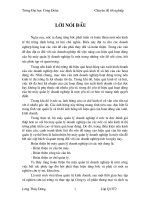4 - xử lý đa tiến trình và dịch vụ
Bạn đang xem bản rút gọn của tài liệu. Xem và tải ngay bản đầy đủ của tài liệu tại đây (4.39 MB, 147 trang )
!
"#!$ $
%&'
(')*+$ ,
%
(')*+$ ,
! ()!
%$ ''$
"-$.'$
"
! ()!
Threads
Android’s threads run in a manner similar to common Java threads
A Thread is a concurrent unit of execution.
not executing in order
has its own call stack for methods being invoked, their arguments and local variables.
Each virtual machine instance has at least one main Thread running when it is started;
The application might decide to launch additional Threads for specific purposes.
! ()!
Multi- Threading
! ()!
Multi- Threading
Threads in the same VM interact and synchronize by the use of shared objects and monitors
associated with these objects.
There are basically two main ways of having a Thread execute application code.
1.Create a new class that extends Thread and override its run() method.
2.Create a new Thread instance passing to it a Runnable object.
In both cases, the start() method must be called to actually execute the new Thread.
/
! ()!
Advantages of Multi- Threading
Threads share the process' resources but are able to execute independently.
Applications responsibilities can be separated main thread runs UI, and slow tasks are sent to
background threads.
Threading provides an useful abstraction of concurrent execution.
Particularly useful in the case of a single process that spawns multiple threads on top of a
multiprocessor system. In this case real parallelism is achieved.
Consequently, a multithreaded program operates faster on computer systems that have multiple
CPUs.
0
! ()!
Disadvantages of Multi- Threading
Code :more complex
Need to detect, avoid, resolve deadlocks
Threads not executing in order
Runnable v.s Thread?
What different?
Deadlock and Atomic type
1
%$ ''$
An application may involve a time-consuming operation, however we want the UI to be responsive to the
user. Android offers two ways for dealing with this scenario:
Do expensive operations in a background service, using notifications to inform users about next
step
Do the slow work in a background thread. Interaction between Android threads is accomplished
using (a) Handler objects and (b) posting Runnable objects to the main view.
2
%$ ''$
When a process is created for your application, its main thread is dedicated to running a message
queue that takes care of managing the top-level application objects (activities, intent receivers, etc) and
any windows they create.
You can create your own secondary threads, and communicate back with the main application thread
through a Handler.
When you create a new Handler, it is bound to the message queue of the thread that is creating it
from that point on, it will deliver messages and runnables to that message queue and execute them as
they come out of the message queue.
3
%$ ''$
There are two main uses for a Handler:
(1)to schedule messages and runnables to be executed as some point in the future; and
(2)to enqueue an action to be performed on another thread
%$ ''$
Threads and UI Warning
Background threads are not allowed to interact with the UI.
Only the main process can access the (main) activity’s view.
(Global) class variables can be seen and updated in the threads
%
%$ ''$
Handler’s MessageQueue
A secondary thread that wants to communicate with the main thread must request a message token using
the obtainMessage() method.
Once obtained, the background thread can fill data into the message token and attach it to the Handler s ‟
message queue using the sendMessage() method.
The Handler uses the handleMessage() method to continuously attend new messages arriving to the main
thread.
A message extracted from the process’ queue can either return some data to the main process or request
the execution of runnable objects through the post() method.
"
%$ ''$
Handler’s MessageQueue
%$ ''$
,$,
$+$ #$.,!( +$
%$ ''$
/
%$ ''$
To send a Message to a Handler, the thread must first invoke obtainMessage() to get the Message object out
of the pool.
There are a few forms of obtainMessage(), allowing you to just create an empty Message object, or
messages holding arguments
Example
// thread 1 produces some local data
String localData = “Greeting from thread 1”;
// thread 1 requests a message & adds localData to it
Message mgs = myHandler.obtainMessage (1, localData);
Messages
0
%$ ''$
sendMessage Method
You deliver the message using one of the sendMessage () family of methods, such as …
•sendMessage() puts the message at the end of the queue immediately
• sendMessageAtFrontOfQueue() puts the message at the front of the queue immediately (versus
the back, as is the default), so your message takes priority over all others
• sendMessageAtTime() puts the message on the queue at the stated time, expressed in the form
of milliseconds based on system uptime (SystemClock.uptimeMillis())
• sendMessageDelayed() puts the message on the queue after a delay, expressed in milliseconds
1
%$ ''$
Processing Messages
To process messages sent by the background threads, your Handler needs to implement the
listener
handleMessage( . . . )
which will be called with each message that appears on the message queue.
There, the handler can update the UI as needed. However, it should still do that work quickly,
as other UI work is suspended until the Handler is done.
2
%$ ''$
Examples
– Using Message
XML Layout
%3
%$ ''$
Coding
4,
%
%$ ''$
Coding
4,
4,
4,!56!57
%%
%$ ''$
Examples – using post
%"
%$ ''$
%
%$ ''$
%
%$ ''$
89 !"
# $%$
&'(!
)*
&!+,






